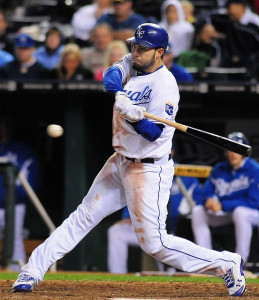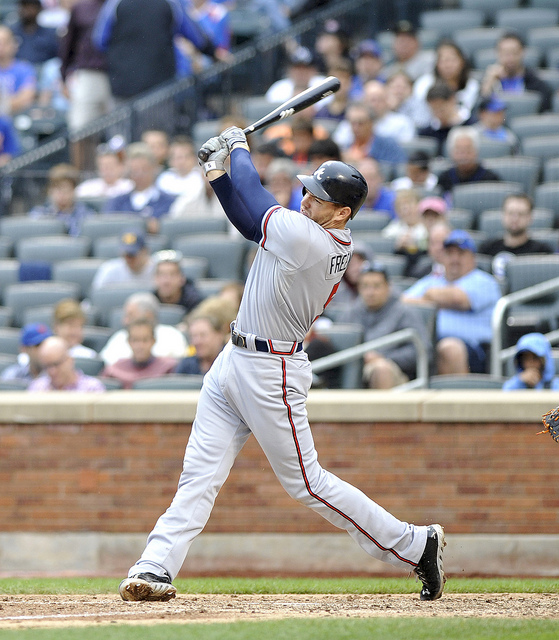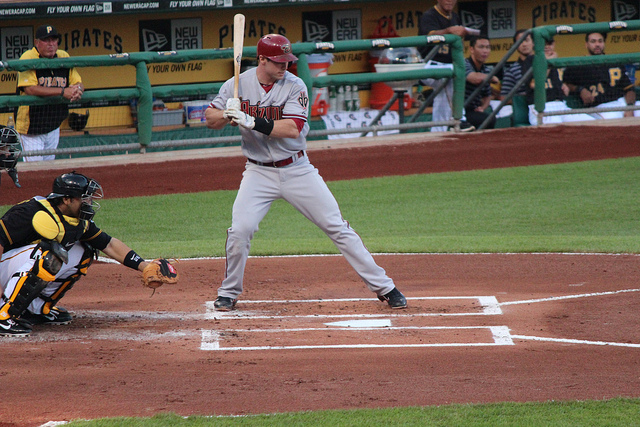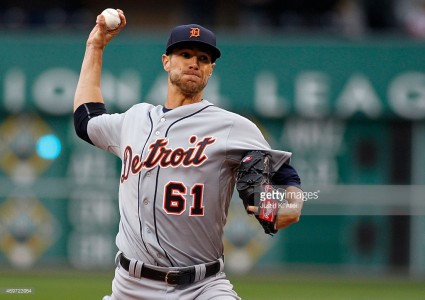2016 Fantasy Baseball Waiver Wire: 3 to Catch, 3 to Cut, 3 to Keep (Week 7)
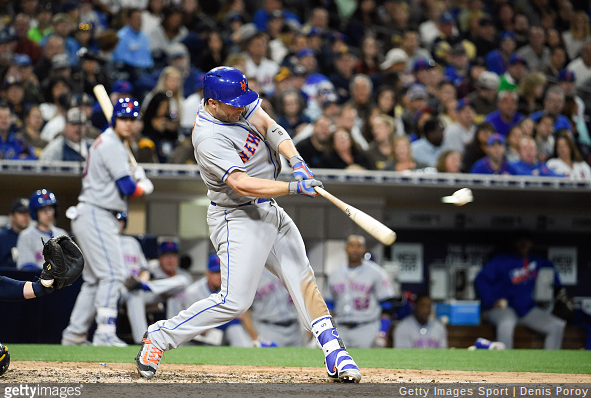
In the newest edition of fantasy baseball 3×3, we’re discovering a new David Wright, correctly regressing Corey Dickerson, and getting honest about Eric Hosmer’s power.
Thoughts, questions, whatever… you can always find me on Twitter.
3 TO CATCH
Players to be picked up; available in most standard leagues
David Wright | New York Mets | 3B
David Wright looks like a new man. Or, more precisely, he looks like a man who’s tired of single-digit home run seasons. This golf shot against the Phillies in mid-April looks more like something we’d see from an all-or-nothing hacker like Trevor Story than from a gap-to-gap hitter like Wright.
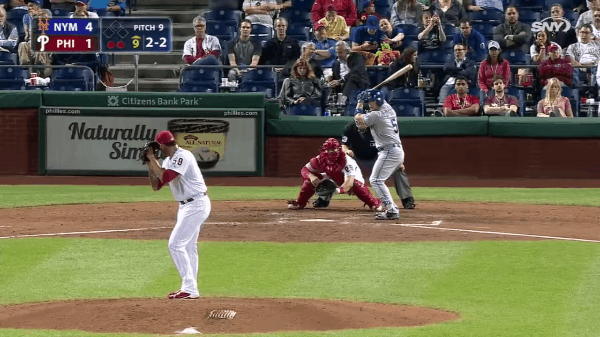
And while Wright remains as patient as ever at the plate, he’s consistently hacking with more malice than we’ve ever seen from him. His contact rate sits at 66.1%, more than 15 percentage points below his career average and more than ten points below his previous single-season low. In most cases, this would be disastrous, but Wright’s decline is so immediate and so severe, I’ve got to believe it’s a purposeful choice to swing harder. Jeff Sullivan confirmed as much at FanGraphs last week (and beat me to the punch on Wright). We’ve only got one year of comparison on batted ball speed, but man, this is a nice looking trendline from Brooks Baseball.
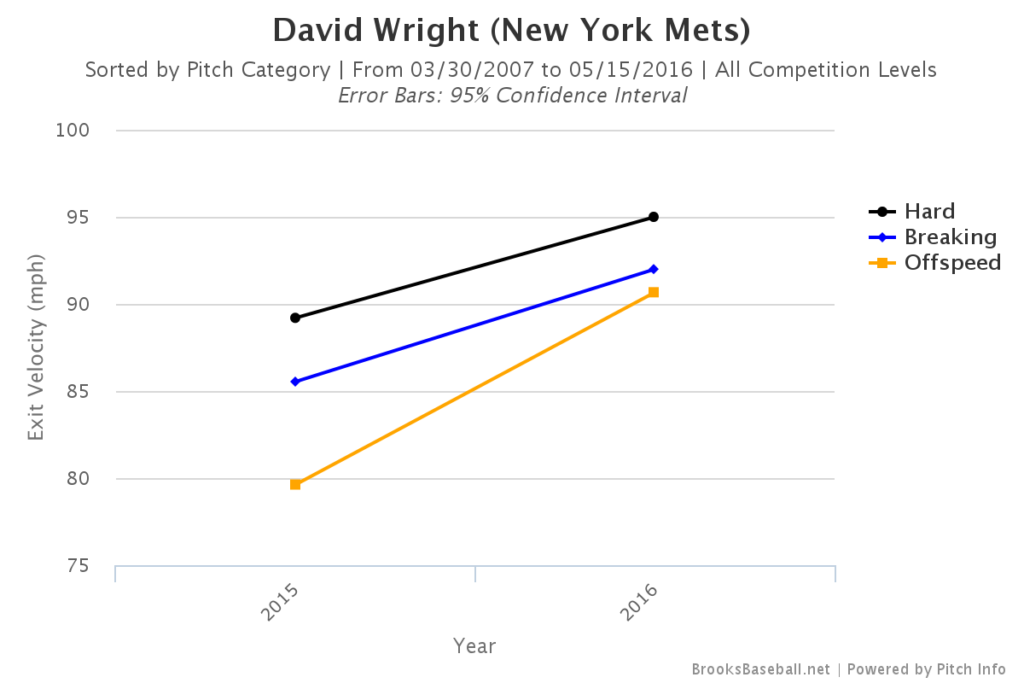
Wright is clearly swinging for the fences. His overall fly ball rate is by far a career high and he’s elevating fastballs at a rate we haven’t seen since 2012, which, not coincidentally, was the last time he hit more than 20 homers in a single season.
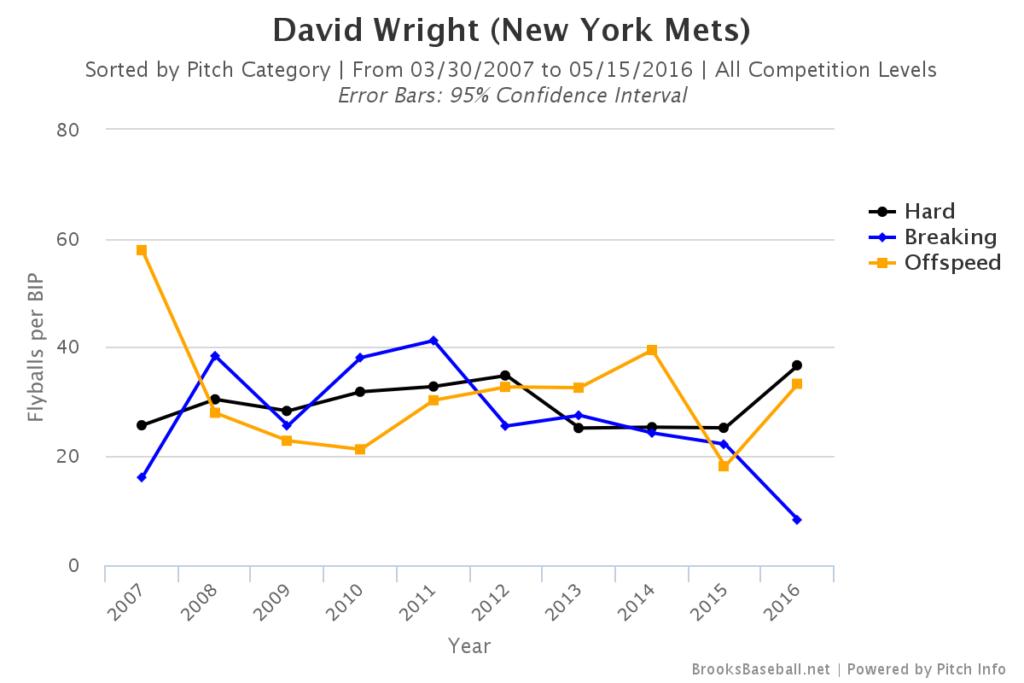
Wright won’t run and he’s nothing near a .300 hitter anymore, but he deserves way more than the four home runs he’s popped so far this season. It’s hard to believe for a player closing in on his 34th birthday, but Wright might be right on the precipice of a power breakout.
To pick him up, I’d drop: Matt Duffy, Brandon Drury, Justin Turner
Rubby de la Rosa | Arizona Diamondbacks | SP
If you’ve been a regular reader of 3×3 over the years, you won’t be at all surprised to see Rubby de la Rosa’s name featured in this space. He’s always been a favorite of mine, I suppose he appeals to the storyteller in me…
De la Rosa is a tragic figure: the pitcher with electric stuff but a nose for the home run ball.
He has ended a season with a HR/9 under 1.00 only once, during his 60-inning rookie campaign back in 2011. Two organizations later, he’s still the talented young kid with a sunspot fastball who inexplicably can’t keep the ball in the ballpark. That’s still mostly true, but it doesn’t account for the other thing that draws me to de la Rosa: his ability recognize his weaknesses and make improvements.
Since his rookie season, he’s cut his walk rate and boosted his groundball rate pretty consistently year-on-year. His strikeout rate has risen each of the past three seasons, peaking at an excellent 9.35 K/9 this year. And despite the fact that Trevor Brown tagged him for a Sunday wall-scraper that kicked his H/9 up to 1.04 on the season, I do think de la Rosa has made an adjustment that can curb his power problem.
It couldn’t be simpler. For his career, his fourseam fastball and slider have been his best pitches in terms of homer prevention. So this season, he’s throwing those pitches more often.
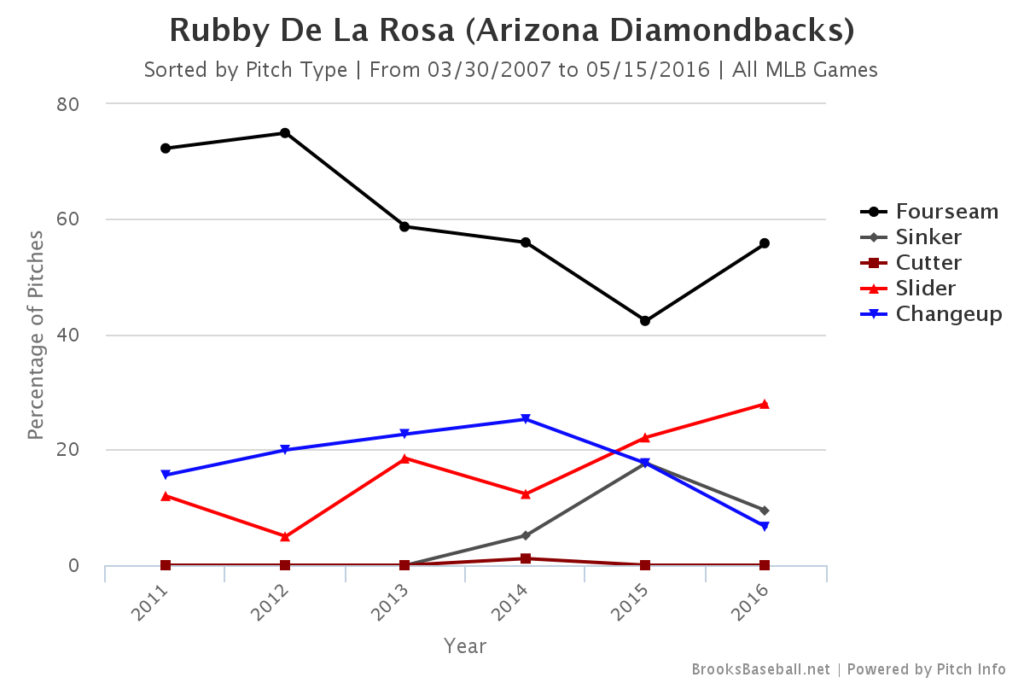
These kinds of pitch mix adjustments aren’t always as simple as they seem, as frequency of use is a key ingredient in the deception that fuels the success of great breaking balls, but that hasn’t been the case with de la Rosa. Per Brooks Baseball, he’s still getting excellent results in terms of whiffs on the slider, despite its increased use.

And though it’s one of his best whiff generators, throwing fewer changeups hasn’t hurt his overall strikeout rate at all. In fact, it’s spiked to a career high.
To pick him up, I’d drop: Nathan Karns, Anibal Sanchez, Hector Santiago
Glen Perkins | Minnesota Twins | RP
Even as he’s only a few bullpen sessions away from a rehab assignment, Glen Perkins’ ownership is hovering around 30% in ESPN leagues. I get it for owners with a short bench a no DL slot, but in most leagues, the Twins presumptive closer deserves to be owned. While we may not know exactly how effective Perkins will be when he returns, we do know that he’s earned the irrevocable “proven closer” moniker, and given the status of the rest of Minnesota’s bullpen, that ought to be enough to get him back into the saddle as soon as he’s physically ready.
Many the the fantasy community have Trevor May pegged as the next option, but I’m not buying it. May has flashed impressive stuff and gaudy strikeout numbers, but righties have tagged him for solid power and he’s already registered two blown saves without ever actually being called upon in a traditional save situation. And if Molitor’s stated need for a closer with experience isn’t enough to scare you off, notice that May melts like an ice cream cone in August when faced with a high leverage situation. Over four high leverage innings, he’s walked nearly a quarter of the batters he’s faced alongside a slight decline in strikeout rate.
Kevin Jepsen has been wishy-washily endorsed as the current closer by manager Paul Molitor, but 5.65 ERA and a 5.06 K/9 that would be embarrassing for a back-end starting pitcher must be enough to pre-heat Jepsen’s chair leading up to Perkins’ return. Once there’s another proven closer around, Molitor won’t hesitate to go back to him.
To pick him up, I’d drop: Ken Giles, Darren O’Day, Drew Storen
3 TO CUT
Players to be traded or dropped, depending on the depth of your league
Eric Hosmer | Kansas City Royals | 1B
Eric Hosmer likes a challenge. Better yet, Eric Hosmer hates shortcuts. Eric Hosmer eats only raw eggs, toasts his bread over an open flame and squeezes his orange juice with his bare hands because breakfast is the most important meal of the day and kitchen appliances and electricity are for cheaters.
Dustin Pedroia’s home run plot tears at the very fabric of Eric Hosmer’s soul. Eric Hosmer doesn’t give a shit about walls, rules, architecture, or park factors. In his world, no ball that travels less than 400 feet has the right to be declared a home run.
I’m speculating, of course, but based on Hosmer’s pattern of power hitting, all of the above must be true. I mean, take a look at his career spray chart. It’s like he’s allergic to the right field line.
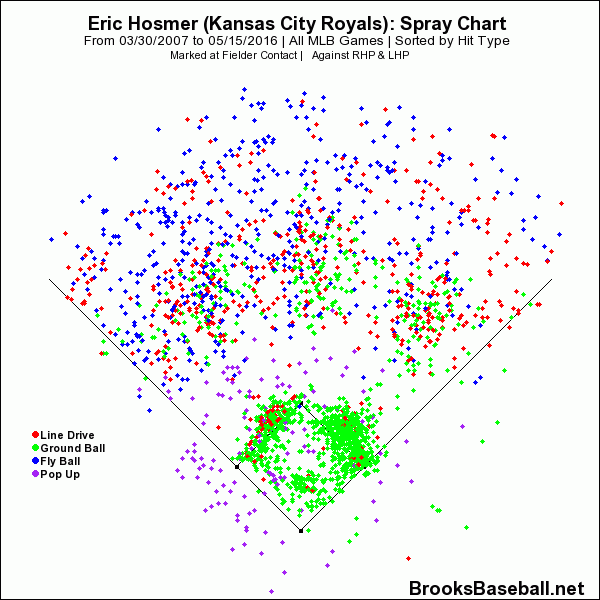
And with that in mind, I’m very skeptical of Eric Hosmer’s fantasy value as a power threat. Last season had a lot of the markings of a power breakout, when he doubled his 2014 home run total to 18 and boosted his HR/FB rate to a career best 15.3%, per FanGraphs. Nobody can take that year away, but keep in mind, eight of his 18 homers last season were rated as “Just Enough” by ESPN’s Home Run Tracker. Now, you could counter this argument by noting that Hosmer wasn’t among the league leaders in total “Just Enoughs” and that guys like J.D. Martinez and Mike Trout doubled that number, but they both also doubled Hosmer’s overall total. Until fantasy leagues take a page from gymnastics are start handing out extra points for degree of difficulty, there’s nothing good about a home run hitter with a bias for handing souvenirs to fans in the front row.
Which brings us back to his approach. Hosmer’s average home run is an impressive 421 feet this season, but only one has gone to straightaway right field. His spray angle against every type of pitch is not only trending toward the middle of the field, but also toward the ground; his groundball rate is peaking at a career high 59.8% while his flyball rate sits about a percentage point below his career average.
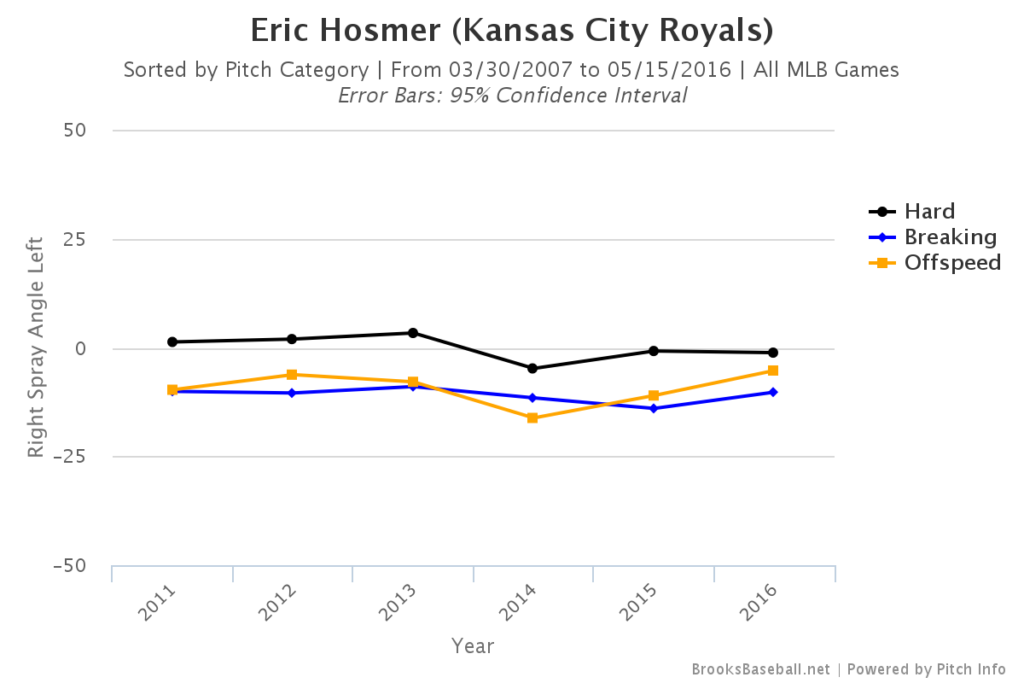
Hosmer can pound the ball with the best of them when he gets a hold of it, but he doesn’t have the kind of approach and natural swing that’ll ever lead to 20-plus home runs. He is a fantastic player, but relative to his powerful peers at first base, that’s always going put him a little behind the pack. If you can convince a rival owner that Hosmer’s power is finally breaking out, don’t be afraid to pull the trigger on a deal.
I’d trade/drop him for: Joey Votto, Hanley Ramirez, Brandon Belt
Carlos Gomez | Houston Astros | OF
For the guys who rely so much on raw talent and aggression, the end comes suddenly and without warning. I’m not saying that Carlos Gomez’ days as a great fantasy contributor are over, but for a player like him, it’s hard to believe that this is just a run of back luck.
His .183/.240/.250 line looks bad, but it’s even worse in the context of a hard contact rate that’s down to its lowest level since 2010 (when Gomez was injured and managed only 318 plate appearances) and swinging strike rate that’s peaking at nearly 20%. He isn’t pulling the ball, sports the 193rd-ranked average fly ball distance in baseball, and hasn’t homered all season after entering 2016 on the heels of a four-year downward trend in HR/FB rate.
Gomez either can’t or won’t dial back his caffeinated approach at the plate. He is not going to age gracefully. His career arc will end with a loud thud, and we might be close to hearing it. Don’t be afraid to sell low.
I’d trade/drop him for: Josh Reddick, Michael Conforto, Yasmany Tomas
Joe Ross | Washington Nationals | SP
If it looks like a breakout, walks like a breakout, and quacks like a breakout… You should probably still check if the dude’s ERA estimators and plate discipline stats can support it.
Joe Ross was outstanding in 13 starts as a rookie last season and at a glance, his three wins, 2.63 ERA, and 3.35 FIP make it seems like he’s only gotten better from there. But the foundation is crumbling behind that facade.
After featuring more fishermen than the Bassmaster Classic last season, Ross is struggling to get hitters to chase out of the zone this year. His chase rate is down eight percentage points, slipping from significantly above average to significantly below. His slider still has the look of a putaway pitch, with terrific movement and only a slight dip in his whiffs per swing…
But it suffers from a lack of deception. Hitters are doing a better job of identifying the slider and laying off, which turns swinging strikes into balls and strikeouts into walks (Ross’ K%-BB% is down about four percentage points). Ever since Ross entered the league, the swing rate on his slider has been trending in the wrong direction.
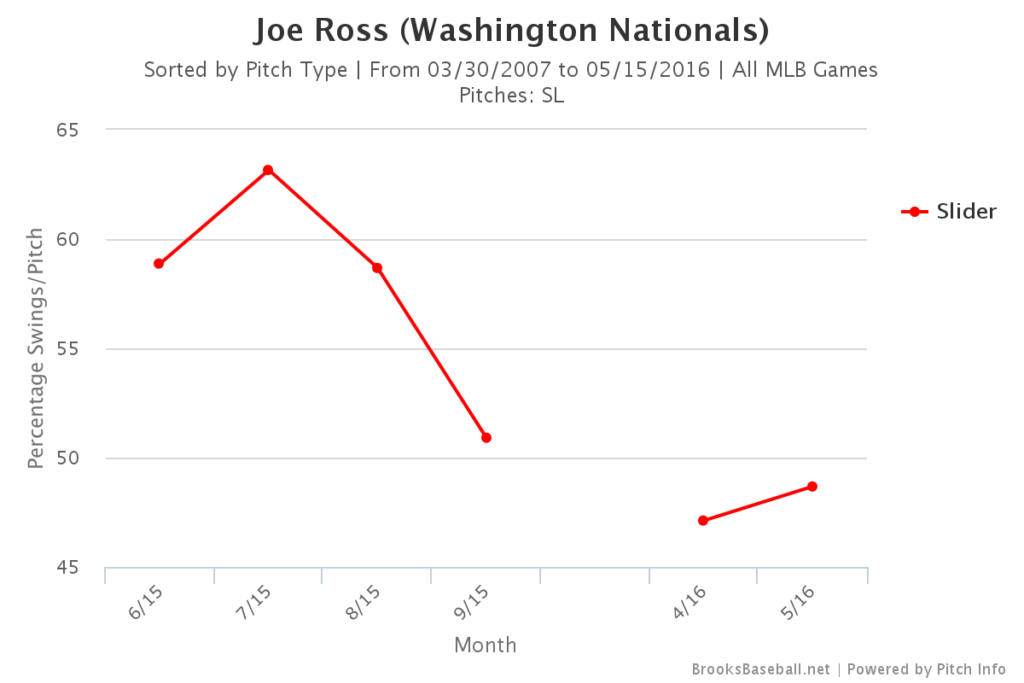
Ross is (or will be soon) a very good pitcher, but he isn’t quite what his stat line suggests and likely won’t bounce back until he’s able to adjust to the adjustments that have been made against him.
I’d trade/drop him for: Drew Pomeranz, Kevin Gausman, Rich Hill
3 TO KEEP
Players to hold or trade for; owned in most standard leagues
Corey Dickerson | Tampa Bay Rays | OF
After hitting over .300 in both of his first two full seasons with Colorado, Corey Dickerson is slashing .183/.248/.481 in Tampa Bay. The narrative is almost too easy.
Hitter is great in Colorado.
Hitter leaves Colorado.
Hitter’s average takes a nose dive.
Analysts cover the internet in “I told you so”s.
But that’s not actually the case here. First off, Dickerson is still stinging the ball. His 92.8 mph average exit velocity ranks among the best in the league, ahead of power hitters like Miguel Cabrera, Anthony Rizzo, and Andrew McCutchen, per MLB.com. His ISO is a career best .287 and he’s one of only a handful of hitters to crank a 450-foot bomb this season, and he did it in pitcher-friendly Tropicana Field.
A hitter generating that much speed off the bat can’t possibly deserve a batting average below the Mendoza line, regardless of what park he hits in. And that’s the odd thing. The root of Dickerson’s struggles isn’t really something that can be attributed to playing in an unfavorable ballpark.
We all know that the thin air in Colorado increases home runs and we all know that Coors Field’s gigantic outfield forces outfielders to play deeper and further apart, which leads to an increased BABIP on line drives and fly balls. Well, Dickerson’s home run power certainly hasn’t diminished, and his BABIP on liners and flies is right around where it was as a Rockie, per FanGraphs.
But the infield is the same size in Colorado. There’s not much reason for grounders to be any more likely to end up as hits, right?
So then why is Dickerson’s BABIP on ground balls down nearly 180 points from last year? He is hitting more soft grounders, but not nearly enough to explain this drop in batting average.
Dickerson won’t be the .300 hitter he was in Colorado, but we probably should have known that coming in. Both Steamer and ZiPS pegged him for a batting average around .260 coming into the season and even after this slow start, both systems have him hitting around .250 the rest of the way. With light tower power and a likely sprinkling of stolen bases, that’s still a tremendously valuable fantasy asset.
I wouldn’t trade/drop him for: Melky Cabrera, Carlos Gomez, Joc Pederson
Alex Colome | Tampa Bay Rays | RP
Brad Boxberger’s footsteps are getting closer and closer to Tampa, but even when he’s back, I don’t think that Alex Colome is a must-drop in every league. I know that Kevin Cash has already made it clear that Boxberger will be the Rays’ closer as soon as he’s able, it’s always best to take a “believe it when I see it” approach to those sorts of statements when the pitcher holding the chair is playing well.
And besides, what’s to say that Boxberger will pitch well enough to keep the role long term? Recovery from core surgery is a strenuous process that’s often riddled with speed bumps (just ask Justin Verlander); we can’t be sure that Boxberger will immediately be himself when he returns.
Colome, however, has been nothing short of brilliant this season. Among full-time closers, only, the Cubs’ Hector Rondon, has posted a better K%-BB% than Colome’s 29.1% and only Rondon, Kenley Jansen, Wade Davis, and Zach Britton can best his 0.87 WHIP. However you want to slice the numbers, he’s been among the best closers in the game.
Even after Boxberger returns and claims the “closer” title, I wouldn’t be surprised at all if Colome still chipped in another half dozen situational saves. At worst, he’ll still have value as a source of strikeouts and WHIP.
I wouldn’t trade/drop him for: Jake McGee, Jeanmar Gomez, Shawn Tolleson
Maikel Franco | Philadelphia Phillies | 3B
Mike Petriello wasn’t talking about fantasy when he pointed it out earlier this week, but his point stands: you can’t afford an offensive negative at third base, there’s just too much talent at the position right now.
And that’s exactly why you shouldn’t drop Maikel Franco, despite a horrific last month. Over the last 30 days, only a dozen hitters have slogged through worse batted ball luck, despite the fact that Franco’s batted ball speed has actually been on the rise lately.
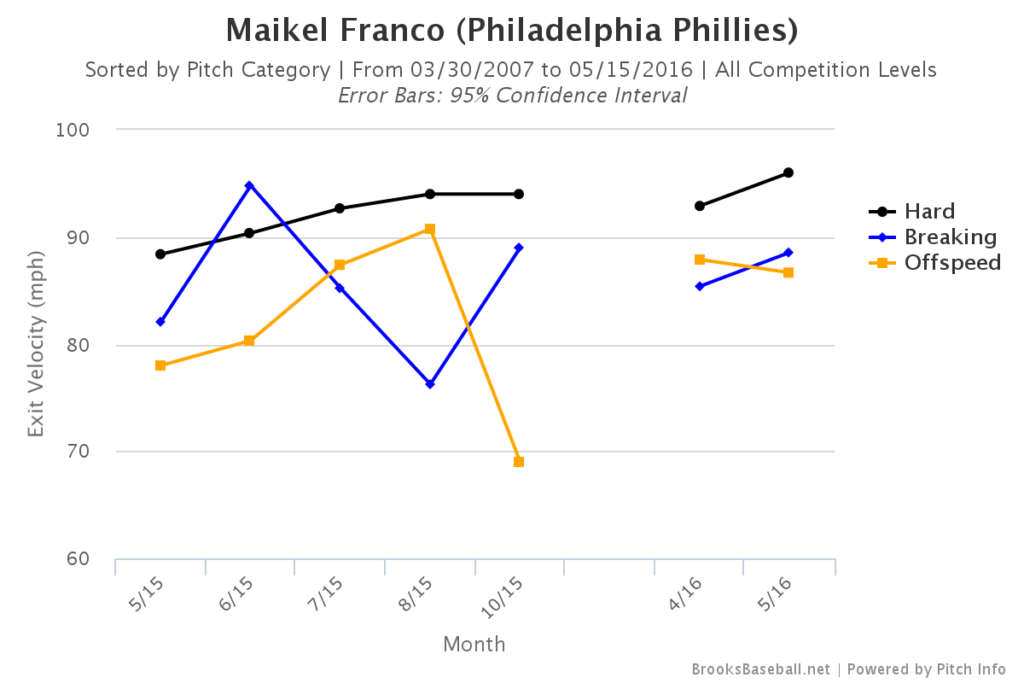
Franco is still generating a lot of fly balls to the pull field and still hitting those fly balls with authority. His strikeout rate is still under control and his plate patience, while still not a strength, remains palatable. He’s going through a bit of a rough patch at the moment, but he remains one of the top offensive contributors at his position.
Just in case you need a reminder, allow me to direct you to this 107 mph scorcher:
I wouldn’t trade/drop him for: Brett Lawrie, Anthony Rendon, Jung ho Kang


